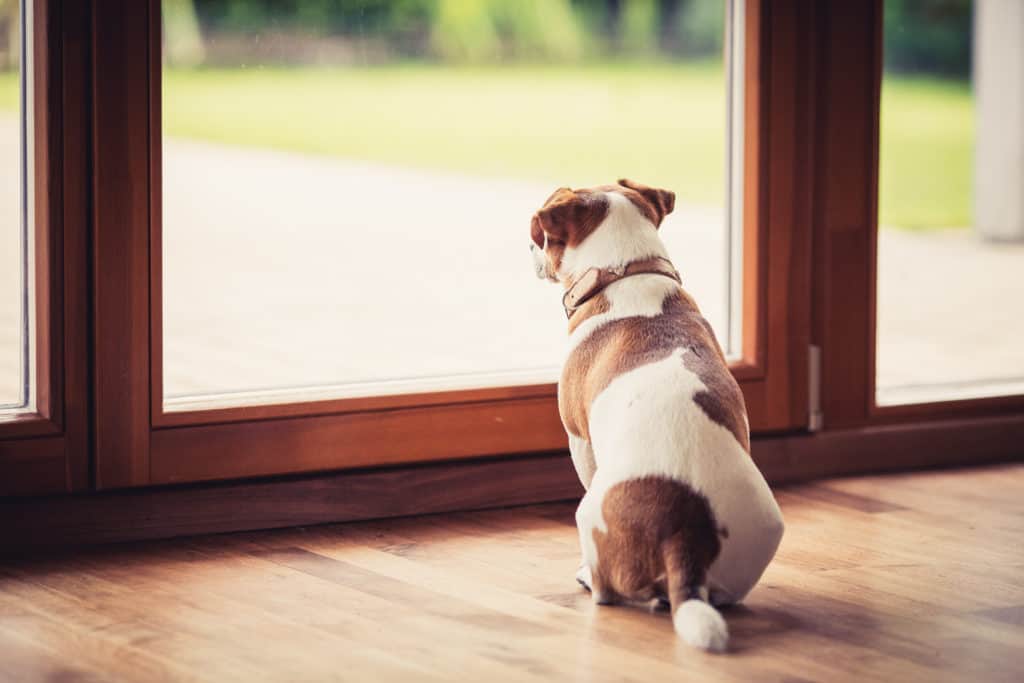You provide everything for your dog. You take them on walks. You bring them on socialization outings. You feed them. You make sure their water bowl is always full. You offer them activities to encourage physical exercise and mental enrichment.
So if you’re meeting all of your dog’s needs and wants (and then some!), why does your dog insist on repeatedly attempting to escape and dash out the front door whenever you open it?
It isn’t because your dog doesn’t appreciate all of the things you do for them; nor is it because your dog dreams of a better life in the big, wide world that awaits them behind your front door. As always with our dogs, the reasons usually lie in instinctive traits which are rooted in their behavioral makeup and living circumstances.
In this article, we’ll take a look at why dogs want to bolt out of the door, and strategies you can adopt to prevent and fix this behavior.
Why should we think about this behavior?
In the grand scheme of things, a dog running out of the front door on a consistent basis may not appear to be a significant behavioral issue requiring a resolution. After all, it doesn’t pose the same immediate dangers like aggression, where a dog bite can have consequences for the dog or human who is bitten, or the dog themselves (quarantine or worse, depending on the severity of the bite, and the jurisdiction in which it occurs).
The act of bolting in and of itself is not the danger; it is the potential consequences that can arise as a result of the bolting that pose the threat to your dog’s welfare.
A dog bolting out of the front door is following its instincts, and is not under any control. This heightened state of behavior can lead to the dog getting themselves into any number of undesirable situations:
- The dog may run so far away from the home that they are difficult to locate.
- In busy subdivisions, a dog may run into the road and put themselves at risk of being struck by a vehicle.
- A neighbor’s dog – who may or may not be on friendly terms with your dog – may be out at the same time, creating an uncontrolled interaction between the two.
- In a rural setting, a bolting dog may just keep on running across fields or woodland, making it even harder for them to be found.
Additionally, for owners, dogs charging out of the front door can bring endless frustration and actually create a situation where they dread opening the door and entering the home at the end of a long work day.
Why dogs bolt out the door
There can be a number of reasons why a dog may charge out the door as soon as it is opened.
If you have been at work all day and are returning home in the evening, the dog may simply be unable to resist the temptation to sprint out the door to greet you. A lack of physical and mental stimulation can make something as mundane as a door opening turn into an exciting event for your pup.
Your dog may have also spotted something of interest when looking outside the front window. A common culprit could be a smaller animal like a squirrel climbing up and down a tree, which triggers your dog’s instinctive prey drive to chase it.
More broadly, the other aspect to consider is that when dogs leave the inside of a home to go outside, typically, it’s for something enjoyable for them. Either you’re taking them on a walk, bringing them on an outing, or even just playing a simple game of fetch in the yard. A doorway leads to the possibility of something fun. For this reason, the behavior becomes, to some extent, self-rewarding – and the dog wants to do it more frequently.

Prevention vs. cure
There are a couple of approaches to dealing with this behavior issue. One method is preventative steps, which don’t contribute to resolving the behavior itself, but can help to manage its consequences; the other strategy involves actually fixing the behavior.
Prevention is likely to provide short-term relief – but in the long run, you will want to resolve this through repeated obedience and practice so that you have better control of your dog.
Preventative steps
In this instance, stopping your dog from charging out of the front door is done by restricting their access to the entryway.
You can do this by confining your dog to a crate whenever you leave the home. This obviously prevents your dog from charging out the door when you open it, but it also has other safety benefits – there is no danger of your dog chewing on something dangerous out of boredom, or indulging in other kinds of destructive behavior.
Another option is to install a barrier or dog gate near your doorway. This allows you to get into the house without fear of being charged at by your pup. One downside of this option is that it doesn’t prevent your dog from actually seeing the door, and won’t stop them from jumping up on the gate. You’ll also have to navigate getting through the dog gate, which may result in your dog jumping on you. However, it will achieve the objective of stopping your dog from making their way outside.
How to resolve dogs charging out the door
The ideal solution for preventing your dog from bolting is by teaching them an alternative behavior to perform when the door is opened. As with all facets of dog training, ensuring consistency with your training and timing is vitally important, which is why it may be beneficial to enlist the help of a professional dog trainer to work through this issue.
To fix this particular behavior, you will need to be able to control the situation and incrementally work on your dog’s threshold to the opening of the door. Bring your dog, their leash, and some treats to the front door. Then, follow this process:
- With the leash attached to your dog, wait for your dog to settle in a sit or down position.
- Open the door very quickly – just an inch – and then close it. If your dog tried to bolt, wait for them to return to their calm sit/down position.
- Repeat this process until you can open the door – even if it is just that inch or two – with your dog remaining in its calm position. Praise your dog for staying in place, then use a release cue (such as “OK!”) to allow them to move.
- Incrementally, increase the amount you open the door – and the duration it is left open for – until you are able to get the door halfway open for a number of seconds with your dog staying in their sit or down command.
- Reward your dog with verbal praise and their treats appropriately to help maintain the behavior.
- Further proof this behavior by having a family member or friend stand on the other side of the door. Encourage them to ring the doorbell, rattle the keys in the lock, move the door handle, or any other behavior that would typically trigger the dog to charge the front door. Again, this should be incremental progress, and it may take several attempts before your dog understands what you’re asking them to do. Continue to encourage your dog’s good behavior by praising them and offering treats – creating a positive association with the behavior.
- Continue to practice this behavior every single time you enter or leave your home. Eventually, your dog will make the connection and it will become second nature for them.
Another alternative to the controlled sit-stay or down-stay is using a place command – asking your dog to lie on their bed when people are at the front door. This can be very useful if you have visitors or guests, but the success of this method does rely on someone being in the home to apply the command.
In summary
When your dog wants to charge out of the front door at every opportunity, it can be a frustrating experience as a dog owner. Even worse, it can create situations where your dog puts themselves in danger.
Teaching reliable obedience and having control of your dog in this situation is transformational! Successfully resolving this behavior does require consistency, practice and timing. If you’re still struggling with your dog charging out the front door, please reach out to us for additional support! Our team of professional dog trainers at Greenside Canine is here to help.

